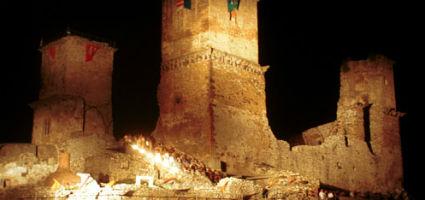2024. April 25. Thursday
The Castle of Diósgyőr - Miskolc - Diósgyőr
 |
Address: 3534, Miskolc - Diósgyőr Vár utca 24.
Phone number: (46) 533-355, (20) 779-9144
E-mail: info@diosgyorivar.hu
Opening hours: 01.05-30.09.: 9-18
01.10-30.04.: 9-17 |
One of the most prominent monuments in Hungary is the Castle of Diósgyőr. The medieval Miskolc was a settlement at the meeting point of the Hungarian Plains and the hilly country. It controlled the wine trading way leading toward Upper Hungary and Poland. The historic monument was built at the gate of the mountain Bükk, just beside Miskolc. It consisted of a castle, monastery and a villein settlement.
The rambles of the castle are pointing high from a rocky hill in the valley of the stream Szinva. This area had been inhabited as early as in the prehistoric age. Anonymus, the notary of Béla III mentioned the castle for the first time in the 12-13. century. The castle originally belonged to the Bors family, but it was destroyed during the Tatar's invasion. Later a stone castle was built instead, which served for the home of Ernye ban. In 1319 this castle was transferred to a Transsylvanian vaivode called Debreczeni Dózsa.
King Louis the Great also liked the place and as a result attached a significant land to it in 1364 and transferred the building into a gothic royal castle. Hence, besides Visegrád and Zólyom Diósgyőr too became a royal residence, and as such it played an important role under the rule of the Polish King Lewis I. The king each year spent several months in the castle where many important historical events took place, such as the ratification of the peace-treaty made in Turin in 1381.
After the death of King Lewis Diósgyőr became the residence of the queens. Between 1424 and 1526 the castle was used as a residence of six queens. The last queen who even lived here was Mary Habsburg, the wife of Louis II.
The defeat at Mohács was a significant turning point for Diósgyőr as well. From this time on the castle the castle was rented out, and after the fall of Egter it turned into a border castle. The castle was transferred into the treasury in 1702, but its renovation was cancelled. After the Ottoman occupation the castle lost all of its strategic value. During the course of time the unattended castle wore down so much that in drawings from the 19th century we can only see its ruins.
Our way leads up to the castle now restored through a flight of stairs. The spacious inner court gives home to various cultural programs, festivals and concerts. Exhibitions can be visited, which present the history of the town; hand weapons of the 14-16th century and the seven-figure panoptic representing the peace-treaty of Torino, a replica of a cannon and a coin press. The biggest waxworks of Middle Europe is found in the castle, where six conversation pieces show the medieval life of the 16th century.
And to cap it all, in the North-East tower a breath-taking panoramic view welcomes the visitors.
The rambles of the castle are pointing high from a rocky hill in the valley of the stream Szinva. This area had been inhabited as early as in the prehistoric age. Anonymus, the notary of Béla III mentioned the castle for the first time in the 12-13. century. The castle originally belonged to the Bors family, but it was destroyed during the Tatar's invasion. Later a stone castle was built instead, which served for the home of Ernye ban. In 1319 this castle was transferred to a Transsylvanian vaivode called Debreczeni Dózsa.
King Louis the Great also liked the place and as a result attached a significant land to it in 1364 and transferred the building into a gothic royal castle. Hence, besides Visegrád and Zólyom Diósgyőr too became a royal residence, and as such it played an important role under the rule of the Polish King Lewis I. The king each year spent several months in the castle where many important historical events took place, such as the ratification of the peace-treaty made in Turin in 1381.
After the death of King Lewis Diósgyőr became the residence of the queens. Between 1424 and 1526 the castle was used as a residence of six queens. The last queen who even lived here was Mary Habsburg, the wife of Louis II.
The defeat at Mohács was a significant turning point for Diósgyőr as well. From this time on the castle the castle was rented out, and after the fall of Egter it turned into a border castle. The castle was transferred into the treasury in 1702, but its renovation was cancelled. After the Ottoman occupation the castle lost all of its strategic value. During the course of time the unattended castle wore down so much that in drawings from the 19th century we can only see its ruins.
Our way leads up to the castle now restored through a flight of stairs. The spacious inner court gives home to various cultural programs, festivals and concerts. Exhibitions can be visited, which present the history of the town; hand weapons of the 14-16th century and the seven-figure panoptic representing the peace-treaty of Torino, a replica of a cannon and a coin press. The biggest waxworks of Middle Europe is found in the castle, where six conversation pieces show the medieval life of the 16th century.
And to cap it all, in the North-East tower a breath-taking panoramic view welcomes the visitors.